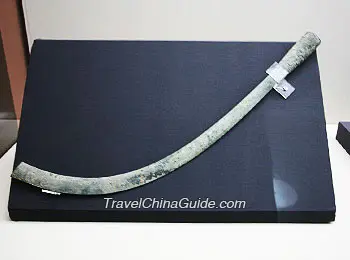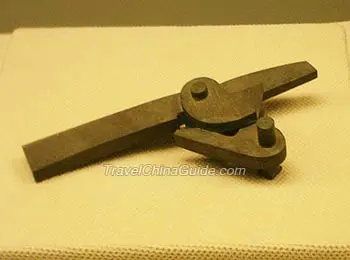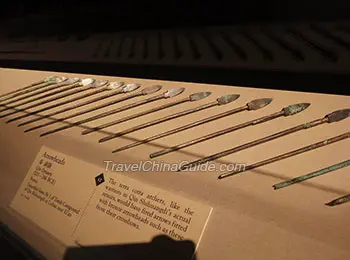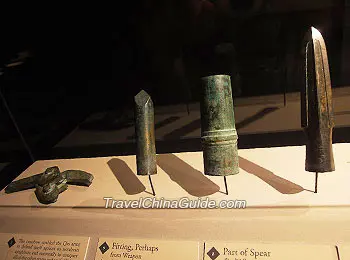Not as Powerful as Imagined
In ancient China, considering the bronze’s fragile property, craftsmen usually made short and wide bronze swords no longer than 60cm (24in). However, when excavating the
Terracotta Army built more than 2,200 years ago, archaeologists were surprised to discover a Qin bronze sword over 91cm (36 in) long in very good condition. So, many people think that the Qin Sword perfectly combined the length, hardness and resilience, making it very powerful. Is that true? To everyone’s disappointment, based on historical records and experimental results, the Qin Sword in the Terracotta Army doesn’t live up to its reputation and is actually very fragile, not powerful as imagined.
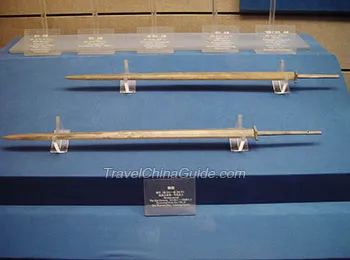 |
| Qin Sword in the Terracotta Army |
More Fatal Iron Sword Already Appeared
Qin Swords are bronze wares made of copper and tin. Most of them were produced during the Warring States Period (475 BC-221 BC). At that time, iron swords also existed. After being carburized, quenched and annealed, the iron swords were more powerful than bronze ones.
Some people may ask, if Qin Swords were not powerful, how did the Qin Army repel its enemies and later unify China? Actually, at that time, both the Qin Army and its enemies still used bronze weapons. That’s because it was very costly and demanding for craftsmen to forge superior iron weapons. Also, poor quality iron was no better than bronze and it was used to cast farm tools and other instruments.
Qin Sword Itself Is Very Brittle.
1. Uneven hardness in different parts
According to the test of the unearthed Qin swords in the Terracotta Army
Pit 1, the average tin content of the Qin Sword is more than 20%, which is rather high. However, the bronze ware with high tin content has a striking feature, that is, different parts will crystallize at different speeds, resulting in different hardnesses. To be specific, the faster a certain part crystallizes, the harder it will be. In terms of the Qin Sword, its thinnest part, the blade, crystallizes more quickly, and accordingly is harder than other parts of the sword. However, the uneven distribution of hardness will damage the mechanical properties of an alloy like bronze. That’s to say, this feature makes the Qin Sword break easily.
2. Imbalance among intensity, plasticity and hardness
If someone wants to make a superior sword, they must balance intensity, plasticity and hardness of the sword. The sword’s blade should have both high intensity and high hardness in order to cut other materials. The rest of the sword should combine high plasticity and hardness to prevent breakage.
As for a bronze sword, its tin content plays a vital role in fulfilling the conditions above. According to the experimental result, the bronze sword’s intensity will reach its peak at 18% tin content, and then decrease as the tin content rises. The plasticity starts to decrease when the tin content exceeds 3%, and almost disappears if the tin content exceeds 20%. Hardness always has a positive correlation with tin content. Apparently, once the tin content of a bronze sword is more than 20%, this sword will have very poor intensity and plasticity. So, it cannot sustain external force and is of no practical value. Since most Qin Swords have more than 20% tin content, it can be inferred that they are not fatal weapons as people imagined.
3. Lack of quenching or annealing techniques
In order to make the Qin Sword more powerful, ancient craftsmen needed to decrease its hardness, so as to increase its plasticity. During the Warring States Period, this could only be done with quenching and annealing techniques. However, were Qin Swords ever quenched or annealed? Researchers examined the Qin Sword in the Terracotta Army, and the result showed that its hardness still reaches 200HB. From this figure, we can infer that the Qin craftsmen simply cast and polished the swords without any quenching or annealing process.
In short, though the Qin Sword’s hardness is high, its low intensity and plasticity still make the sword extremely brittle. It is as fragile as glass or ceramics we see in daily life.
Its length can be a disadvantage, instead of advantage.
Compared with other contemporary bronze swords, Qin Swords were truly longer with an average length over 80cm (31in). Some people believe that this design enabled Qin soldiers to kill their enemies more easily. But, the weapon’s length is not an absolute advantage. First, as discussed above, the Qin Sword is already thin and brittle, and such length will only make it more likely to fracture. Second, the length of a weapon should be in accordance with the Army’s tactics. Especially when the army attacks on the basis of matrix, long weapons will probably damage the soldiers’ dense and neat arrangement. That’s why the ancient Greek troops once changed their long swords into shorter ones.
Chromium on its surface is a coincidence, instead of anti-rust technique.
When testing the chemical composition of the Qin Sword, researchers found that its surface has a ten-micron layer of chromium compound. This reminds people of a modern anti-rust technique called Chromium Plate Coating. And some people think that the Qin people had already mastered this skill over 2,200 years ahead of the world. Nevertheless, many experts don’t support this assumption for five reasons. First, there are very few unearthed bronze wares that contain chromium are very little, thus an insufficient number from which to make a conclusion. Second, the chromium content on the Qin Sword is extremely small, less than tin, copper, silicon, lead, iron, aluminum and sulphur. Third, there is no sound evidence to prove the chromium’s ornamental or anti-rust function. Fourth, from the test, experts found that the chromium content is uneven, which makes it seem that it was not applied on purpose. Last, so far, there hasn’t been any written record indicating the use of chromium in ancient China.
Therefore, experts hold that the chromium on the Qin sword is sheer coincidence. Some believe that this chemical element results from the soil erosion. A more wide-spreading explanation is as they were buried underground the Qin Swords were stained by the lacquer of the Terracotta Warriors, which also contains chromium.
What was the Qin sword used for? - An ornament or grave good instead of weapon.
Through the analysis above, we can find that the Qin Sword was too brittle to be the practical weapon in a real battlefield. So, what was it used for? Apparently, its ultimate function is a grave good for
Emperor Qin Shi Huang (259 BC-210 BC), to represent his authority. In addition, some experts speculate that the Qin Sword could also be an ornament used by ancient people to show their social status and their power to command, protect, reward or punish others.
- Last updated on Aug. 04, 2025 by Alex Jin -

